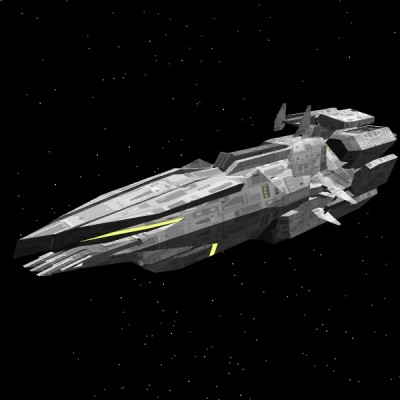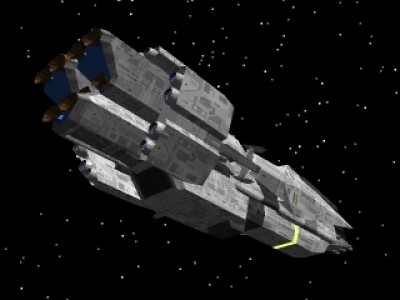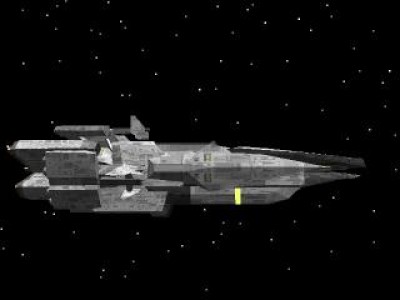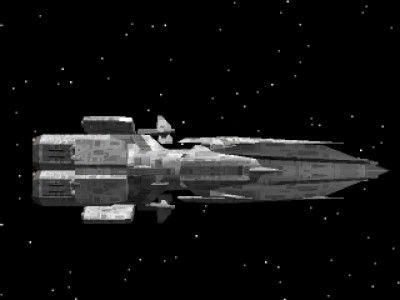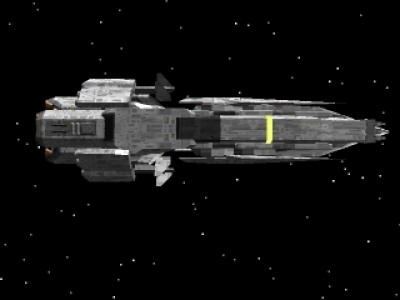Table of Contents
NDC-SS1
The S6-SS1 is a joint project between Iemochi Innovations & Sales, Frontier Service Corporation, and Section 6.
In late YE 39, the corporate competition of Iemochi Innovations & Sales and the Frontier Service Corporation came to a head during Section 6's proposed supplement to their engineering teams by bringing in outside expertise. Through several iterations of corporate idealism, members of Section 6 and IIS suggested a joint project, to be built using FSC's heavy industry and workforce pool and designed with the help of the OSO and IIS's engineering teams. The result is a nimble cruiser with innovative features and surprising maneuverability and speed, for its bulky frame. It also boasts interesting counter-detection systems to make it look less of a threat, and powerful weapons to pack a deserved punch.
About the Ship
Bordering in size and weapon style of a cruiser-carrier, but with main weapons and point defenses more inline with a frigate, classifying this warship became a matter of semantics. With updates coming to increase its versatility, the SS1 class is sure to prove a powerful tool in any firefight or simple support operation.
Key Features
The SS1 is a fast frigate optimized for rapidly deploying Section 6's small commando units.
Mission Specialization
The SS1's increased speed-to-size ratio (due to sacrificing firepower) makes the craft much more nimble than other vessels of its class.
- Hit and Run
- Convoy Raiding
- Stealth
Appearance
The ship is of a triplicate hull design, with the upper and lower forms mirroring in trunicated spikes, leaving an open forecastle. Underneath is a large hangar bay that can be used for orbital deployment of fighters, drop craft, or cargo loading, and several fin stabilizers across the midsection allow control in atmosphere or other dense space. The third portion of the hull is a ring of thruster complexes, three in total, that allow thrust vectoring and rapid change in direction even at full speed.
There are three much larger engines on the rear side of the inner mass, providing main thrust and lending a polished, refined touch to an otherwise simple and efficient design.
History and Background
The ship itself was originally envisioned by Jack Pine in mid YE 39 with much of the finishing touches, technology, and final design work handled by the Frontier Service Corporation, and Section 6.
Statistics and Performance
The SS1 uses advanced technology sourced from OSO's contacts, and has a large amount of its mass devoted to its engines, giving it a high Delta-V.
General
- Class: CSW-F1-1A
- Type: Heavy Frigate
- Fielded by: New Dusk Conclave, IIS
Passengers
Crew: 100 operators are recommended, 50 are required.
Maximum Capacity: There are accommodations for 300 people. About 800 people can fit aboard in an emergency, but the ship would be extremely cramped.
Dimensions
- Length: 140 meters
- Width: 60 meters
- Height: 60 meters
- Decks: 10 (2.5 meters floor to ceiling each)
Propulsion and Range
- Hyperspace Fold Drive: 75 ly/hr
- Sublight Engines: .35c, 0 relative velocity to full speed in 95 seconds.
- Range: 3 Yamataian months, or 10^3 lightyears before refuelling
- Lifespan: 30 Yamataian years with proper maintenance.
- Refit Cycle: 6 years, with proper maintenance.
Damage Capacity
DRv3 Tier: 11
Inside the Ship
The SS1 is a fairly spacious ship, designed with the intention of supporting small craft and the large crew compliment needed for ground or space operations. Even the hallways are considerably wider than normal to allow for transfer of large objects or storage of additional equipment.
Compartment Layouts
The SS1 has the following compartments.
Armory
Large size room located towards the aft section of the ship on the deck connected above the hangar and rear bay. Forward half contains personal arms lockers lining the walls and arranged in the center, and in the rear half of the room is the security arms section. This is where onboard security personnel obtain and store there weapons other than their sidearms.
Bridge
Located forward and on deck two and three, and consist a two story half-circle room. The higher rear portion on deck two is the Captains chair which comes with a command station, XO and CO chairs forward and to the left and right of the captain's station in recesses in the floor that also come with there own stations. The front lower section is on deck three and has the science, engineering, damage control, comms, weapons, and navigation stations arranged around the rooms outer edge in recesses in the floor that sit in alcoves built into the walls. The Helmsman station sits forward most front on floor level and in a deep alcove. Each station is fitted with glass interface displays, and physical keys and controls, with the chairs equipped with safety restraint harnesses can be sealed by deployable armor shells in case of emergencies such as a deep hull breach. The captains station has the same glass displays as well as holographic displays that also lower from the compartments ceiling which stays at deck two height for the entire room. The center of the compartments ceiling includes a holo-projector that displays star maps brought up and analyzed by the navigation station, but displays unit locations in combat situations. Each station in an alcove has the unigue feature of the walls of the alcove acting as displays giving an encircling 180 degree view of station related data, with the helmsman station having a 270 degree surrounding with its deeper alcove. There is a door to either side on both levels for entry to the bridge as well as conduit accesses in the corners. Finally as a recently added feature, the captains chair has been outfitted to improve synchronization with a Geist implant.
Captain's Suite
The captains suite is located just aft of the bridge on deck two. It a spacious room that includes, a double bed, desk with terminal, personal bathroom, small siting area with coffee table and seating(a couch and two lounging chairs), wardrobe compartment unit, trophy/model/picture display shelving, and a large glass pane wall mounted display for comms, entertainment, and ship data/rosters. There is a door leading to the bridge, and one leading aft to the wardroom.
Cargo Storage Areas
Located in the ships underside large rear bay, this is a large multiple level area where cargo and stored items are kept.
Crew Cabins
Located mid-ship in the central decks, this is where the crew sleep and consist of bunk style rooms that have shared lavatories and siting areas with lockers and footlockers for personal storage. Finally, each room features a large shared glass pane wall mounted display.
Crew Recreation
These are located at either end of the crew cabin sections both towards the aft and prow. They are medium rooms with exercise equipment, a sparring room, and a sitting area with glass pane displays.
Engineering
This is where the drive system is located with the majority of the ships secondary systems, and spans several decks in the aft section of the ship taking up the 1/5 of the ship.
Maintenance Conduits
Cramped crawl spaces that run through the ship's superstructure to allow access to the ships inner working and sub-systems.
Medical Center
A large room composed of two wards, one on either side of the ship located on the upper decks with the main part of the compartment in the center connecting the two wards. Comes fully stocked and staffed, with the OSO's best medical equipment.
Passageways
Corridors run throughout the ship to provide access in conjunction with lifts, and are only three feet wide.
Power Armor Bays
This large room is actually connected to both the hangar and rear bay and is entered after leaving the armory, and is located lower decks of mid-ship section. The first half of the room contains lockers for picking up and equipping the base suite of Revenant PA before moving to the second half of the room where the armor pieces await in special rigging stations to be attached on by mechanical arms.
Hangar
This is visible from the outside and includes a launch catapult system, of this section which is located at the lowest part of the ship towards the prow. It can hold ten U-1 Production Model Variable Mecha's, or other small craft.
Rear Bay
Located farthest aft on the lowest decks of the ship, the rear bay both functions as the cargo hold as well as a bay for large vehicles, or dropships. It spans five decks high, and has a rear hatch.
Wardroom
This long medium sized room is located aft of the captains loft and is furnished in formal decor. A nice polished wood cased table with a holo-system integrated at it's center with keypads at every seat. Nice leather chairs are positioned around the table, and a door in each corner for entrance from the corridors outside. A fifth door that is on the prow most wall, leads into the captains loft. There are also glass pane display screens mounted on the walls and hanging above the table, with flags of the OSO, Section6/Saber hanging on the walls as well.
Ship Systems
Armored Hull and Hull Integrated Systems
The SS1 usues Durandium Alloy armor throughout its construction.
<NOTE: See Damage Rating (Version 3) for more info on damage ratings>
Computers and Electronics
Four electronics units stored internally provide for all of the computing power and storage requirements of the ship.
Emergency Systems
IIS designs inspired by the Star Army Standard Starship Emergency Systems.
Life Support Systems
6 life support units provide for the life support functions of the ship, and are connected to a comprehensive life support / waste processing system that spans the ship.
Propulsion
12X plasma rotor main engines 8X graviton induction drives
Sensors
The SS1 uses over 300 optical sensors spaced around the outer hull for basic optical and thermal detection. 6 subspace radar systems are also positioned inside of the ship to provide 360 degrees of coverage.
Shield Systems
The SS1 uses a scaled up version of a power armor shield system to provide a protective shield around the ship to defend against attacks and provide artifical gravity. These shields are placed around the hull of the ship, and inbetween decks.
Weapons Systems
- 4 Light anti-starship Rotary Pulse Laser Battery: DRv3 Tier 10/9
- 10 Starfighter Primary Laser Turret: DRv3 Tier 7
Vehicle Complement
The SS1 can carry a single shuttle and a squadron of 8 U-1 Production Model Variable Mecha
OOC Notes
Created by Jack Pine, Madi Harper, ethereal and Rizzo. Submitted by Kim and approved by Ametheliana and Zack on 01 Jan 2018.
| Products & Items Database | |
|---|---|
| Product Categories | starships |
| Product Name | SS1 class Frigate |
| Nomenclature | CSW-F1-1A |
| Manufacturer | Conclave Ship Works, Iemochi Innovations & Sales, Frontier Service Corporation |
